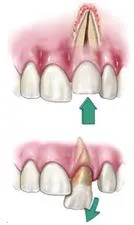Do you have a Dental Emergency? We have 4 Doctors available | Schedule Today
Do you have a Dental Emergency? We have 4 Doctors available | Schedule Today

TRAUMATIC DENTAL INJURIES
Traumatic dental injuries often occur in accidents or sports-related injuries. Chipped teeth account for the majority of all dental injuries. Dislodged or knocked-out teeth are examples of less frequent, but more severe injuries. Treatment depends on the type, location and severity of each injury. Any dental injury, even if apparently mild, requires examination by a dentist or an endodontist immediately. Sometimes, neighboring teeth suffer an additional, unnoticed injury that will only be detected by a thorough dental exam. Endodontists are dentists who specialize in treating traumatic dental injuries. With their advanced skills, techniques and technologies, Rancho Bernardo Endodontics can often save injured teeth.
How will my injury be treated?

Chipped or Fractured Teeth
Most chipped or fractured tooth crowns can be repaired either by reattaching the broken piece or by placing a tooth-colored filling. If a significant portion of the tooth crown is broken off, an artificial crown or “cap” may be needed to restore the tooth.
If the pulp is exposed or damaged after a crown fracture, root canal treatment may be needed. These injuries require special attention. If breathing through your mouth or drinking fluids is painful, bite on clean gauze or cloth to help relieve symptoms until reaching your dentist’s office. Never use topical pain medications (such as Anbesol ®), or place aspirin on the affected areas to eliminate symptoms.
Injuries in the back teeth often include fractured cusps, cracked teeth and the more serious split tooth. If cracks extend into the root, root canal treatment and a full coverage crown may be needed to restore function to the tooth. Split teeth may require extraction.

Dislodged (Luxated) Teeth
During an injury, a tooth may be pushed sideways, out of or into its socket. Your endodontist or general dentist will reposition and stabilize your tooth. Root canal treatment is usually needed for permanent teeth that have been dislodged and should be started a few days following the injury. Medication such as calcium hydroxide may be put inside the tooth as part of the root canal treatment. A permanent root canal filling will be placed at a later date.
Children between seven and 12 years old may not need root canal treatment since their teeth are still developing. For those patients, an endodontist or dentist will monitor the healing carefully and intervene immediately if any unfavorable changes appear.
Therefore, multiple follow-up appointments are likely to be needed. New research indicates that stem cells present in the pulps of young people can be stimulated to complete root growth and heal the pulp following injuries or infection.

Knocked-Out (Avulsed) Teeth
If a tooth is completely knocked out of your mouth, time is of the essence. See an endodontist or dentist immediately! Handle the knocked-out tooth very gently, avoiding touching the root surface and to protect the tooth.
Your endodontist or dentist will carefully evaluate the tooth, place it back in its socket and examine you for any other dental and facial injuries. A stabilizing splint will be placed for a few weeks. Depending on the stage of root development, your dentist or endodontist may start root canal treatment a week or two later. A medication may be placed inside the tooth followed by a permanent root canal filling at a later date.
The length of time the tooth was out of the mouth and the way the tooth was stored before reaching the dentist influence the chances of saving the tooth. Again, immediate treatment is essential. Taking all these factors into account, your dentist or endodontist may discuss other treatment options with you.

Root Fractures
A traumatic injury to the tooth may also result in a horizontal root fracture. The location of the fracture determines the long-term health of the tooth. If the fracture is close to the root tip, the chances for success are much better. However, the closer the fracture is to the gum line, the poorer the long-term success rate. Sometimes, stabilization with a splint is required for a period of time.

Do traumatic dental injuries differ in children?
Chipped primary (baby) teeth can be esthetically restored. Dislodged primary teeth can, in rare cases, be repositioned. However, primary teeth that have been knocked out typically should not be replanted. This is because the replantation of a knocked-out primary tooth may cause further and permanent damage to the underlying permanent tooth that is growing inside the bone.
Children’s permanent teeth that are not fully developed at the time of the injury need special attention and careful follow-up, but not all of them will need root canal treatment. In an immature permanent tooth, the blood supply to the tooth and the presence of stem cells in the region may enable your dentist or endodontist to stimulate continued root growth.
Endodontists have the knowledge and skill to treat incompletely formed roots in children so that, in some instances, the roots can continue to develop. Endodontists will do all that is possible to save the natural tooth. These specialists are the logical source of information and expertise for children who are victims of dental trauma.
Will the tooth need any special care or additional treatment?
The nature of the injury, the length of time from injury to treatment, how your tooth was cared for after the injury and your body’s response all affect the long-term health of the tooth. Timely treatment is particularly important with dislodged or knocked-out teeth in order to prevent root resorption.
Resorption occurs when your body, through its own defense mechanisms, begins to reject your own tooth in response to the traumatic injury. Following the injury, you should return to your dentist or endodontist to have the tooth examined and/or treated at regular intervals for up to five years to ensure that root resorption is not occurring and that surrounding tissues continue to heal. It has to be noted that some types of resorption are untreatable.
Reproduced and used by permission – Copyright © 1995-2014 American Association of Endodontists (AAE)
TRAUMATIC DENTAL INJURIES
Traumatic dental injuries often occur in accidents or sports-related injuries. Chipped teeth account for the majority of all dental injuries. Dislodged or knocked-out teeth are examples of less frequent, but more severe injuries. Treatment depends on the type, location and severity of each injury. Any dental injury, even if apparently mild, requires examination by a dentist or an endodontist immediately. Sometimes, neighboring teeth suffer an additional, unnoticed injury that will only be detected by a thorough dental exam. Endodontists are dentists who specialize in treating traumatic dental injuries. With their advanced skills, techniques and technologies, Rancho Bernardo Endodontics can often save injured teeth.
How will my injury be treated?

Chipped or Fractured Teeth
Most chipped or fractured tooth crowns can be repaired either by reattaching the broken piece or by placing a tooth-colored filling. If a significant portion of the tooth crown is broken off, an artificial crown or “cap” may be needed to restore the tooth.
If the pulp is exposed or damaged after a crown fracture, root canal treatment may be needed. These injuries require special attention. If breathing through your mouth or drinking fluids is painful, bite on clean gauze or cloth to help relieve symptoms until reaching your dentist’s office. Never use topical pain medications (such as Anbesol ®), or place aspirin on the affected areas to eliminate symptoms.
Injuries in the back teeth often include fractured cusps, cracked teeth and the more serious split tooth. If cracks extend into the root, root canal treatment and a full coverage crown may be needed to restore function to the tooth. Split teeth may require extraction.

Dislodged (Luxated) Teeth
During an injury, a tooth may be pushed sideways, out of or into its socket. Your endodontist or general dentist will reposition and stabilize your tooth. Root canal treatment is usually needed for permanent teeth that have been dislodged and should be started a few days following the injury. Medication such as calcium hydroxide may be put inside the tooth as part of the root canal treatment. A permanent root canal filling will be placed at a later date.
Children between seven and 12 years old may not need root canal treatment since their teeth are still developing. For those patients, an endodontist or dentist will monitor the healing carefully and intervene immediately if any unfavorable changes appear.
Therefore, multiple follow-up appointments are likely to be needed. New research indicates that stem cells present in the pulps of young people can be stimulated to complete root growth and heal the pulp following injuries or infection.

Knocked-Out (Avulsed) Teeth
If a tooth is completely knocked out of your mouth, time is of the essence. See an endodontist or dentist immediately! Handle the knocked-out tooth very gently, avoiding touching the root surface and to protect the tooth.
Your endodontist or dentist will carefully evaluate the tooth, place it back in its socket and examine you for any other dental and facial injuries. A stabilizing splint will be placed for a few weeks. Depending on the stage of root development, your dentist or endodontist may start root canal treatment a week or two later. A medication may be placed inside the tooth followed by a permanent root canal filling at a later date.
The length of time the tooth was out of the mouth and the way the tooth was stored before reaching the dentist influence the chances of saving the tooth. Again, immediate treatment is essential. Taking all these factors into account, your dentist or endodontist may discuss other treatment options with you.

Root Fractures
A traumatic injury to the tooth may also result in a horizontal root fracture. The location of the fracture determines the long-term health of the tooth. If the fracture is close to the root tip, the chances for success are much better. However, the closer the fracture is to the gum line, the poorer the long-term success rate. Sometimes, stabilization with a splint is required for a period of time.

Do traumatic dental injuries differ in children?
Chipped primary (baby) teeth can be esthetically restored. Dislodged primary teeth can, in rare cases, be repositioned. However, primary teeth that have been knocked out typically should not be replanted. This is because the replantation of a knocked-out primary tooth may cause further and permanent damage to the underlying permanent tooth that is growing inside the bone.
Children’s permanent teeth that are not fully developed at the time of the injury need special attention and careful follow-up, but not all of them will need root canal treatment. In an immature permanent tooth, the blood supply to the tooth and the presence of stem cells in the region may enable your dentist or endodontist to stimulate continued root growth.
Endodontists have the knowledge and skill to treat incompletely formed roots in children so that, in some instances, the roots can continue to develop. Endodontists will do all that is possible to save the natural tooth. These specialists are the logical source of information and expertise for children who are victims of dental trauma.
Will the tooth need any special care or additional treatment?
The nature of the injury, the length of time from injury to treatment, how your tooth was cared for after the injury and your body’s response all affect the long-term health of the tooth. Timely treatment is particularly important with dislodged or knocked-out teeth in order to prevent root resorption.
Resorption occurs when your body, through its own defense mechanisms, begins to reject your own tooth in response to the traumatic injury. Following the injury, you should return to your dentist or endodontist to have the tooth examined and/or treated at regular intervals for up to five years to ensure that root resorption is not occurring and that surrounding tissues continue to heal. It has to be noted that some types of resorption are untreatable.
Reproduced and used by permission – Copyright © 1995-2014 American Association of Endodontists (AAE)
CONTACT US TO SCHEDULE YOUR CONSULTATION
CONTACT US TO SCHEDULE YOUR CONSULTATION
Serving the entire
San Diego Metro Area
Including:
* Rancho Bernardo
* Rancho Santa Fe
* Poway
* Ramona
* Escondido
* 4S Ranch
* Scripps Ranch
* Mira Mesa
* Torry Del Mar
RANCHO BERNARDO
ENDODONTICS
© 2025 Rancho Bernardo Endodontics. All Rights Reserved.
Serving the San Diego Metro Area
RANCHO BERNARDO
ENDODONTICS
16466 Bernardo Center Drive, Suite 176, San Diego, CA 92128 Tel: (858) 676-6709 Fax: (858) 541-7019
© 2022 Rancho Bernardo Endodontics. All Rights Reserved.


